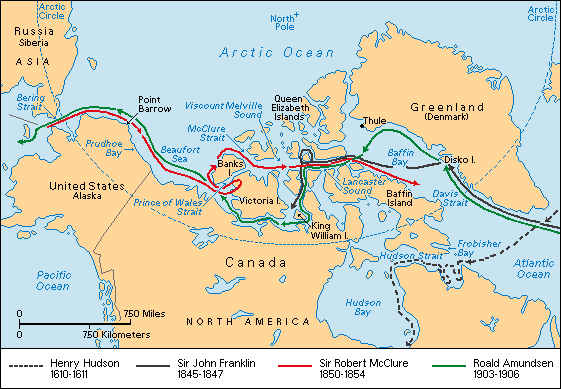Ship Missing in the Arctic Since the 1800′s Found By Divers
September 9, 2014
Canadian Prime Minister Stephen Harper announced that a team of underwater archaeologists have discovered the wreck of one of two ships from the ill-fated Franklin expedition of 1845 in the waters of the Victoria Strait in the Arctic Ocean. Experts have searched for the wreckage for years. The discovery may help solve one of most enduring mysteries in World exploration–what became of English adventurer Sir John Franklin and his crew after they voyaged from England to find the fabled Northwest Passage, a northern water route across North America?

Routes traveled by explorers in search of a northern sea passage between Europe and Asia. The English explorer Henry Hudson, sailing for the Dutch East India Company, led an expedition in search of the passage in 1610 and 1611. Other expeditions included those by the British explorers Sir John Franklin (1845-1847) and Sir Robert McClure (1850-1854) and by the Norwegian explorer Roald Amundsen (1903-1906).
In the early 1800′s, the Royal Navy began sending expeditions to try to find a Northwest Passage in Arctic waters north of Canada. In 1845, Sir John Franklin, sent out to search for the passage, left England with 128 men aboard two ships, HMS Terror and HMS Erebus. It was the best-equipped expedition to enter the Arctic at that time. However, in September 1846, the ships were trapped by thick sea ice near King William Island. Franklin and several crewmen died there several months later. When no one returned from the voyage, Lady Franklin in 1848 sponsored the first of many expeditions to search for her husband. A full exploration of the Arctic resulted, but the ships and crew were never found. Later, explorers found evidence of Franklin’s party, including a written message left on King William Island in 1848 indicated that 105 surviving crew abandoned the ships that were hopelessly jammed in ice. Local Inuit people told the explorers stories that indicated some of the crew survived for years. However, none survived to return. The expedition’s fate became one of the great mysteries of the Age of Exploration in the 1800’s.
Since 2008, archaeologist with the Parks Canada service have conducted searches for the lost Franklin Expedition ships using sophisticated 3-dimensional sonar operated from a remote underwater vehicle to survey hundreds of square miles of seabed in the Arctic ocean. On September 7, the sonar detected the remnants of a large wooden ship on the Arctic seafloor. The detailed sonar images show the bow and stern of the ship and some of the deck structures are still intact, including the mainmast. The researchers believe that many items inside the ship are probably well preserved in the cold Arctic waters. However, they have not yet been able to determine if the wreckage is from the HMS Terror or the HMS Erebus.
The researchers stated that further investigation would be needed to identify the wreck and determine the state of preservation. However, no detailed plans have been announced.


